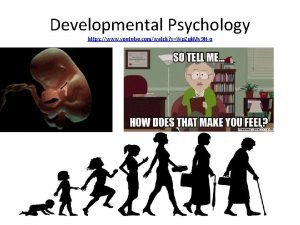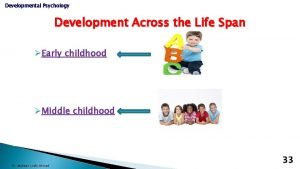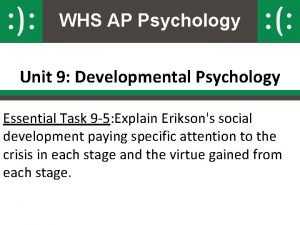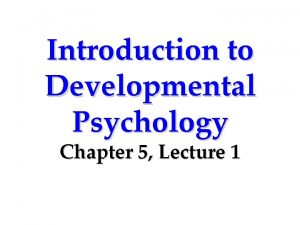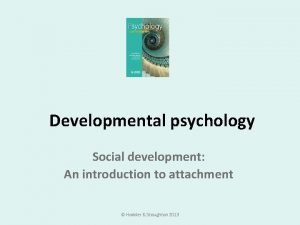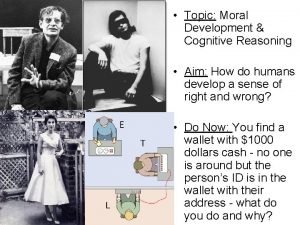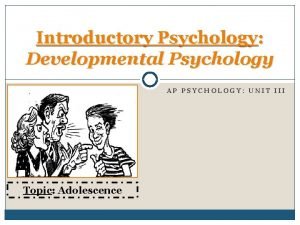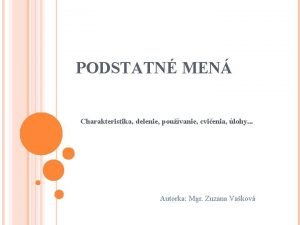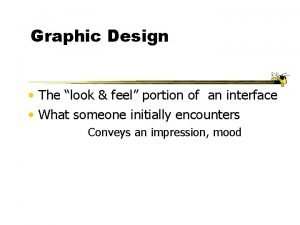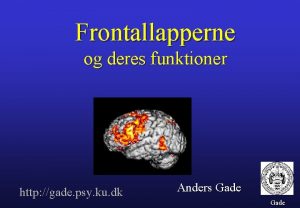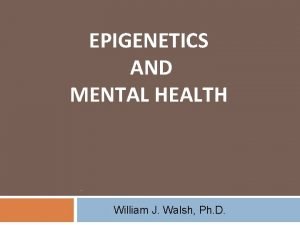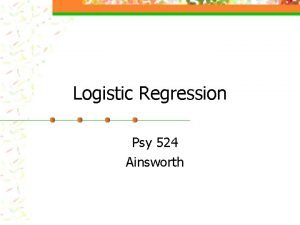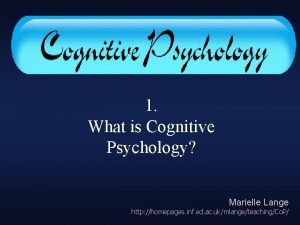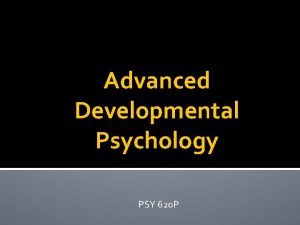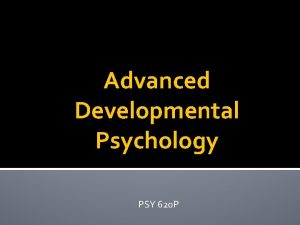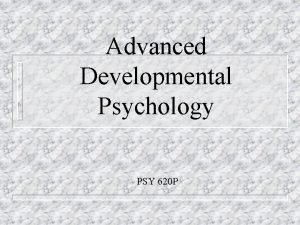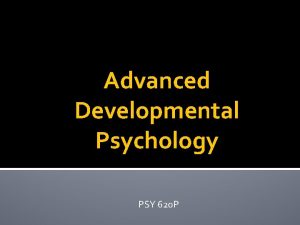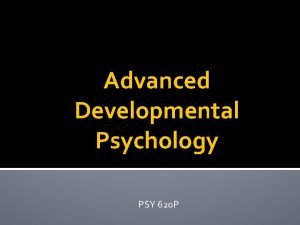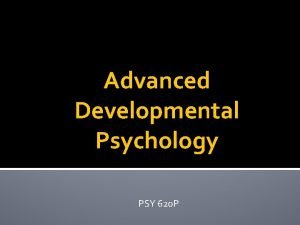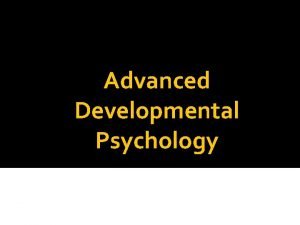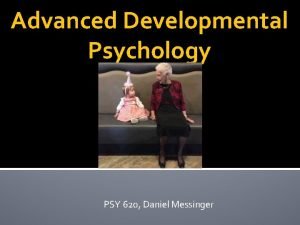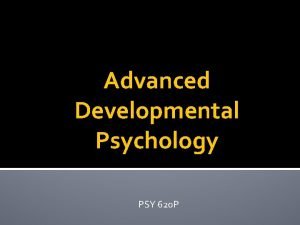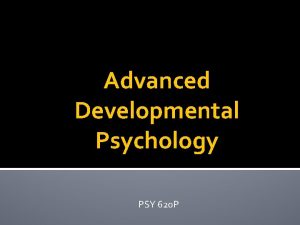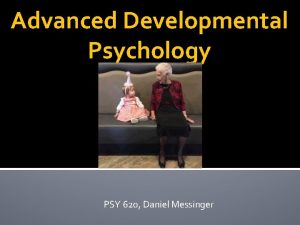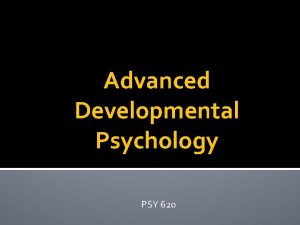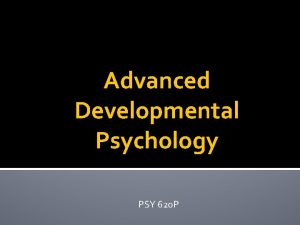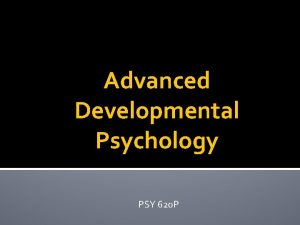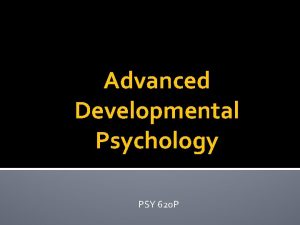Advanced Developmental Psychology PSY 620 P Domains of











































- Slides: 43

Advanced Developmental Psychology PSY 620 P

Domains of Development �Perception �Cognition �Language �Social/Emotional

Overview � Contingent feedback changes how infants vocalize what would Chomsky think (what about Romeo et al’s results)? � SES, parent speech, and child language outcome MLU review (ppt 13) Hart & Risley’s classic—maternal speech & SES Hoff—maternal speech vs SES Hirsh-Pasek-quality of speech (fluency & connectedness Romeo--Vocal turn-taking and brain development Quittner—Strategies for deaf parents Age at implantation Debbie school data—peers � First words � High-chair learning

Vernon-Feagans et al. (2012) �Chaos structure

Large representative sample of children living in low wealth rural communities Vernon-Feagans et al. (2012)

Socioeconomic status differences in language experience are associated with later child language competence and IQ Meaningful differences in the everyday experiences of young American children. Hart & Risley (1995). Baltimore, MD: Brookes Publishing Co 13

Quantity of language: Nouns, adjectives, and adverbs to child 14

How language experience is associated with later child IQ � “Parenting” = Language diversity + feedback tone + symbolic emphasis + guidance style + responsiveness � Predicts between and within SES groups 15

Language experience—not SES— makes the difference 16

Implications for intervention Hart & Risley � ‘Could easily increase the size of the children’s vocabularies, could not accelerate the developmental trajectory. ’ � “Removing barriers and offering opportunities and incentives is not enough to overcome the past, the transmission across generations of a culture of poverty. ” 17


SES Parenting Child language Hoff (2003) 25

How? SES affects maternal speech �Childrearing beliefs �Time availability Maternal speech mediates relationship between SES & vocabulary Maternal speech affects language growth �child’s word-learning mechanisms �Longer utterance -> more variance in word types (richer vocabulary) �Longer utterance -> more info about meaning �Longer utterance -> richer syntax

Hirsh-Pasek et al. (2015)

Background • Children in poverty hear significantly fewer words than do more affluent kids • “ 30 million word gap” • gap is related to lower IQ, vocabulary, and language processing efficiency • Programs and interventions designed to increase quantity of language input, but quantity isn’t the only thing that matters! • Need to consider… • Quality of language input • Sensitive parenting

Current Study • Authors wanted to specifically examine 3 dyadic features of communication quality and children’s later language outcome: 1. Joint Engagement with symbols 2. Routines and Rituals 3. Fluency and Connectedness

Current Study Research Questions: 1. Do low-income children who are successful language learners experience a higher quality communication foundation during early mother-child interactions than their less-verbal peers? 2. How important is the quantity of language that children hear relative to the quality of this communication foundation? 3. Does the quality of communication foundation, the quantity of language input, or both, predict later language outcome over and above what is predicted by sensitive parenting? https: //youtu. be/x. Ys 8 hf. ENv. Bs

Methods • Sample Selection: • From the NICHD Study of Early Child Care and Youth Development dataset (Side note: Recruited in 1991) • 1, 130 total pool in which 158 fulfilled criteria • 20 children selected from low, mid, and high terciles of expressive language scores • Participants: • Only low-income • 60 parent-child dyads • Children’s mean age = 25. 2 months • 37% Black non-Hispanic and 63% White non-Hispanic • No significant differences in mother’s education

Methods Measures: • Sensitive Parenting: • Composite rating of maternal sensitivity • Measure of stimulation and responsiveness of the family environment • Three-Boxes Task: • 15 minute videorecordings of mother-child interaction • Mother given 3 boxes with different contents and instructed to play with child as she normally would • Coded for symbol-infused joint engagement, routines and rituals, and fluency and connectedness on a scale of 1 to 7 • Language Outcome: • Reynell Developmental Language Scales (at 36 months)

Results- RQ 1 • • Children who scored in the top third of expressive language norms had significantly higher ratings on all three indicators of 24 -month communication quality than children in the bottom third No significant differences in quantity

Results- RQ 2 & 3

Results- Exploring quality

Conclusions & Implications • Quality of early communication predicts expressive language over and above maternal sensitivity and quantity • Why? • Fluency and connectedness may be especially important for language development • Demonstrates what contributes to language success in a low income sample • Indicates the need to further clarify influential aspects of caregiver-toddler interactions on language development and develop interventions focused on encouraging a “conversational duet”

Discussion Questions • Strengths and weaknesses on the methods? • Sample selection? • Only using expressive-vocab score? • Thoughts on the Three-Boxes task? • Might context play a role in the quality of communication foundation? • Thoughts on the long term effect of quality of language input? Does it continue to have an impact longitudinally? And continue to matter more than quantity and sensitive parenting? • Is it possible that this effect doesn't matter so long as the child goes on to be in a language enriching environment in early childhood? • Implications for intervention development? According to these results, fluency and connectedness is a strong predictor of children’s later language. Thoughts on strategies that caregivers can use to better promote this?


SES IQ & Verbal Composite

SES adult words & turn-count

Conversational turns composite verbal Composite verbal scores were created by averaging the PPVT-4 standard score and the CELF-5 CLS.

Conversational turns—activation

Moderated by left inferior frontal gyrus


90% of children with hearing loss born to hearing parents Maternal sensitivity SES Age of cochlear implantation Duration of auditory deprivation Parental linguistic input ▪ Quantitative (Word types, Mean length of utterance) ▪ Qualitative (Facilitative language techniques [FLTs]) ▪ Structured tasks better facilitators of oral communication

Parent language practices child language Cruz, et al. , 2013

Houston et al. (2012)

Early implantation, better discrimination

68

Proportions of Word Categories Children from Hong Kong Children from the US Children from Beijing

Language Development Theories– Interactionist Perspective � Language development most likely occurs via interactions between inner capacities and environmental influences ▪ ▪ Visual context of noun learning (shape bias) Social context of language learning (performatives) Auditory context Statistical learning Iconicity Lynn Perry

Highchair philosophers: the impact of seating contextdependent exploration on children’s naming biases Lynn K. Perry, Larissa K. Samuelson, and Johanna B. Burdinie • Differences between solid objects and nonsolid substances lead to an early appreciation of their distinction • Does naming of nonsolids improve if children are tested in typical/familiar context of highchair during mealtime? • Children tested in the highchair demonstrated better understanding of how nonsolids are named, demonstrating a developmental cascade between context, exploration, and word learning

• Child was given the exemplar object and the two test items to explore • experimenter asked children to find “their own” exemplar, either by name (warm up), with novel names (test), or with no name Figure 1 Example stimuli sets used in experiment. Left panel shows a whole exemplar set; right panel shows a pieces exemplar set. • Coded the final choice (shape versus material)


Highchair material bias

Related to increasing messy touches in high-chair
 Sublimimation
Sublimimation Research methods in developmental psychology
Research methods in developmental psychology Devonte is a graduate student in developmental psychology
Devonte is a graduate student in developmental psychology Developmental psychology
Developmental psychology Wilhelm wundt structuralism
Wilhelm wundt structuralism Authoritariam
Authoritariam Ap psychology unit 9
Ap psychology unit 9 Chapter 5 developmental psychology
Chapter 5 developmental psychology What was john bowlby attachment theory
What was john bowlby attachment theory Ucf psychology major
Ucf psychology major Lawrence kohlberg developmental psychology
Lawrence kohlberg developmental psychology Adolescence ap psychology
Adolescence ap psychology Ngdali
Ngdali Psy
Psy Psy
Psy Psy 2055
Psy 2055 Psy ku
Psy ku Psy
Psy 11 psy
11 psy Psy 335 purdue
Psy 335 purdue Psy 226
Psy 226 Psy2055
Psy2055 Psy 2055
Psy 2055 Psy walsh
Psy walsh Psy
Psy When sam listens to his girlfriend susan
When sam listens to his girlfriend susan Psy
Psy Opis mačky po anglicky
Opis mačky po anglicky Regression psy
Regression psy Phonological loop
Phonological loop Euro psy
Euro psy Psy academy
Psy academy Psy sanin
Psy sanin 5 major domains of psychology
5 major domains of psychology 5 major domains of psychology
5 major domains of psychology +91 620 421 838
+91 620 421 838 Mdcrs
Mdcrs Was julius caesar a good emperor
Was julius caesar a good emperor Iata special provision a140
Iata special provision a140 Buck saeta
Buck saeta Meam 620
Meam 620 Isa 620 using the work of an expert
Isa 620 using the work of an expert 12vac35-105-520
12vac35-105-520 Jms 620
Jms 620
